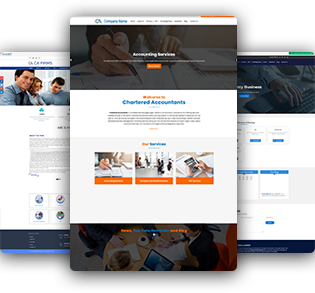
In the dynamic field of website design, tapping into the potential of templates has become a fundamental pillar for enhancing efficiency, fostering creativity, and ensuring functionality. Developing a visually appealing and user-friendly website requires navigating through a complex web of design elements, and templates offer a strategic guide for this journey. Whether you’re an experienced web designer or a newcomer navigating the digital terrain, grasping the most effective ways to utilize templates can significantly streamline your workflow and enhance the overall aesthetic and performance of your website.
This exploration into the “Optimal Use of Templates in Website Design” delves into the numerous advantages of templates, provides insights into practical implementation strategies, and emphasizes their crucial role in shaping the contemporary web experience. Join us as we uncover the strategies to unlock the full potential of templates in the pursuit of striking, responsive, and seamlessly functional web designs.
Providing user experiences by designing a website from the start might be challenging. Brands need to weigh multiple elements, including navigation, responsiveness, cross-browser compatibility, content structure, branding, and other factors, while also aiming for an attractive layout. Because 89% of customers are likely to switch to a competitor if they encounter a subpar user experience on the brand’s website.
Developing a website demands deep familiarity with web technologies, creativity, meticulousness, and a customer-centric approach—the absence of which can pose obstacles in the process.
What if crafting an exceptional website didn’t necessitate coding? This can be achieved through website templates or, for instance, opting for a Do-It-For-Me service. However, templates can be alluring.
Utilizing website templates proves advantageous by eradicating the arduous task of building a website from the ground up. They provide a pre-designed and highly optimized framework for launching a professional-grade website. Crafted by skilled designers, these templates adhere to the latest design and development trends and incorporate best practices.
In this article, we’ll outline the primary advantages and drawbacks of employing templates in website design. This will aid in making an informed decision on whether to utilize a template for designing your company’s website.
When to utilize the Website Templates
Before moving forward, let’s explore certain scenarios in which using the templates for the website design shall be advantageous.
1. Low Budget
When you have limitations in your budget website design templates are a magnificent choice, as custom website development could be expensive. Template usage is a cheaper solution since it removes the requirement to employ professional designers and website developers for designing the website and development work.
It assists in creating an attractive website that’s both visually appealing and fully functional, all without exceeding your limited budget.
2. No Complex Conditions
Website templates offer a perfect fit for businesses that need simple websites without extensive customization. With pre-designed layouts, navigation, structures, and necessary features already in place, templates streamline basic website creation. Instead of starting from scratch, you can swiftly set up your website by incorporating pertinent content and graphics.
According to Derek Bruce, Operations Director at Skills Training Group, templates are most suitable for informational websites, blogs, portfolios, small business sites, and other static website types.
3. Tight Deadlines
Website templates are ready-to-use tools that can greatly speed up the process of planning and building a website. Simply add your preferred content and images to get started.
They become the perfect option for teams dealing with tight schedules. Employing templates for website development cuts down the time needed to create a website from the ground up, enabling you to launch it quicker than anticipated.
Carefully explore different templates and choose the one that aligns with your project needs and fits within your budget.
Build Your Online Presence with CA Portal’s Website Templates
Advantages of Utilizing Templates in Website Design
In website design let’s now comprehend the pros and cons of using templates.
1. Get Your Website Up and Running Quickly
Utilizing website templates speeds up the website launch process. With pre-existing designs and structures, you avoid the need to construct every element of the website from the ground up.
Simply pick a fitting template and tailor it to suit your content and brand, saving time and effort.
This allows you to concentrate on tailoring your website with precise content, images, videos, branding, and more. You don’t require exceptional technical or design skills as these templates offer user-friendly interfaces. They feature drag-and-drop editors for effortless modifications.
Thanks to these capabilities, templates expedite website launches, appealing particularly to businesses aiming for a swift online presence.
2. Many Templates Are Free or Very cheap
Numerous website builders, online template repositories, and open-source platforms provide attractive, professional templates either for free or at budget-friendly rates.
Professional designers and developers contribute these templates as a free resource to the community. Opting for a free template is an excellent choice when working with a tight budget.
Additionally, various web design marketplaces offer reasonably priced premium templates. These affordable premium options boast numerous features, customization choices, regular updates, and customer support, enabling you to craft a polished website without overspending.
3. Plenty of Templates
A vast array of website design templates awaits your selection. Numerous platforms and marketplaces offer an extensive spectrum of choices in templates.
Whether you seek a template for an eCommerce platform, business site, blog, or portfolio, the options are plentiful. These templates cover diverse industries and niches.
They offer a myriad of design options, encompassing various website structures and layouts. From single-page to multi-page templates, magazine-style to grid-based layouts, and even fullscreen image or card layouts, the choices are abundant. Beyond layout variations, customization options abound—alter fonts, images, colours, buttons, and other design elements. This versatility enables the creation a modern, visually appealing website that embodies your brand’s identity.
4. Responsiveness
Website design poses responsiveness which is an important part.
Were you aware that 73.1% of web designers identified non-responsive websites as the primary reason customers abandon a site? That’s why ensuring your website provides a consistent experience across all devices is crucial.
Countless templates exist that seamlessly adjust a website’s layout, content, and functionality across various devices and screen sizes. This eradicates the necessity for users to zoom, pinch, or horizontally scroll through your site’s content. These templates incorporate touch-friendly navigation, readable text sizes, and appropriately scaled images, guaranteeing a uniform and user-friendly experience regardless of whether users access the site via desktop, tablet, or mobile devices.
5. You Know What you will receive
Utilizing website design templates comes with the advantage of clear expectations. These templates offer a visual portrayal of the final website, enabling you to assess the design, layout, colour schemes, typography, and overall aesthetics beforehand.
This preview aids in gauging if the template harmonizes with your brand identity and preferred style. It provides insight into content organization and customer navigation.
Many template providers offer preview or demo features, permitting interaction with the template before finalizing. This assessment helps evaluate website navigation, page structures, responsiveness, and the overall user experience, empowering informed decisions.
6. Additional Third-Party Applications
Most templates readily integrate with various third-party applications, providing valuable functionality and features for websites. These applications, available as plugins, extensions, or widgets, offer a diverse array of capabilities.
Leveraging these third-party applications enables website enhancement with eCommerce tools, contact forms, social media integration, image galleries, SEO optimization, analytics tracking, and more. These tools offer extensive customization options, allowing website owners to tailor appearance and functionality to meet specific needs. This ensures seamless integration of applications with the website’s overall design and branding, resulting in a unified and coherent user experience.
7. No Coding Knowledge needed
Using templates removes the requirement for comprehensive coding skills when building the website.
Templates arrive pre-designed and pre-coded, offering an instant structure and layout for your website. They frequently include user-friendly interfaces or intuitive content management systems (CMS) for easy customization without code.
Equipped with an intuitive editor, these templates enable modifications like adjusting colors and fonts, inserting new images and videos, and more, directly via the template’s interface. This user-friendly functionality, whether through drag-and-drop features or dropdown menus, empowers non-technical users to craft professional websites effortlessly.
Cons of Using Templates in Website Design
While website templates offer advantages, they also present drawbacks and constraints. Nevertheless, these limitations can be addressed and even transformed into opportunities. Let’s explore three primary constraints encountered in website design templates.
1. Template Designs Need More Work
Using website templates can be limiting due to their lack of unique designs, requiring adjustments to achieve better outcomes.
Because templates are pre-designed and accessible to a broad audience, numerous businesses will likely use the same template, albeit with minor modifications. This can result in a lack of uniqueness for your website, increasing the likelihood of encountering other sites sporting similar or identical designs.
It might seem like a challenge if you aim to create a website that distinguishes itself from competitors and establishes a unique brand identity. Yet, by making slight adjustments and leveraging your coding abilities, even employing simple CSS techniques, you can achieve more impressive results.
2. Limited (but Limitless) Template Customization
Although templates typically provide customization choices, their flexibility is often constrained. However, this limitation doesn’t restrict other means of editing the website. Templates serve as a starting point, and you can certainly employ third-party tools to further enhance your site’s visuals.
Going beyond the offered customization options in templates might demand advanced coding skills or technical know-how, posing challenges for those without such expertise. This limitation can hinder the creation of a website precisely tailored to meet your unique design preferences and brand specifications.
3. Additional Features Cost Extra
When employing templates for website design, it’s essential to factor in potential additional costs linked to extra features. While many templates are either free or reasonably priced, catering to those with budget constraints, they might come with limited functionalities.
Accessing more advanced features often entails purchasing premium plugins or add-ons separately.
Gaining access to advanced functionalities or additional features might require purchasing premium templates or investing in add-ons and plugins. These could encompass advanced sliders, eCommerce integrations, custom forms, membership systems, or specialized widgets, among others.
4. Integration Can be Difficult or Impossible to Implement
Templates, with their specific design structures and coding conventions, can present challenges when integrating third-party applications, complex functionalities, or custom solutions into your website. Not all external integrations or functionalities seamlessly align with your template’s framework.
At times, the template’s design or code might not sync smoothly with the desired integration, creating hurdles or rendering certain features difficult or impossible to implement seamlessly.
This mismatch can lead to conflicts, errors, or gaps in functionality when incorporating external services or functionalities into your website. Resolving these issues might demand extensive customization efforts, potentially surpassing your coding expertise or available resources, thereby significantly increasing costs.
5. Lack of Support
Free templates often don’t offer the same support as their premium counterparts from providers.
Securing dependable support can prove challenging if you encounter issues or require assistance with customization or troubleshooting. The absence of this support can prolong issue resolution, affect your website’s functionality, and impede the overall development progress.
6. Not SEO-Friendly
Templates frequently prioritize aesthetics and functionality over SEO considerations during their creation. Consequently, they might lack essential elements crucial for SEO success. Templates not optimized for search engines could impact your website’s visibility in search results.
For effective search engine optimization (SEO), elements like clean code structure, correct heading hierarchy, appropriate meta tags, and mobile responsiveness play vital roles. A template lacking these key elements might demand manual adjustments or additional optimization efforts to enhance its SEO performance.
7. Slower Site Speed
Templates often arrive with pre-built components, scripts, and styles that might surge the complete file size and decrease the website’s loading speed.
Sluggish loading times can harm user experience, elevate bounce rates, and influence search engine rankings. Enhancing site speed might necessitate optimizing the template’s code and assets, a task that typically demands technical know-how or exploring resources like the HostPapa Blog for insights and guidance on web development.
What is the need to Build a Custom Website?
When weighing the advantages and disadvantages of using templates for website design, opting to create a custom website from the ground up becomes a compelling choice. Here are several reasons to contemplate building a bespoke website for your brand.
1. Unique needs
Choosing custom website development becomes a sensible choice when your website demands specific features that can’t be met through a template. Through custom development, you can craft a highly efficient website that prioritizes top-notch user experiences.
This approach grants you the flexibility to create a website aligned with your brand identity, keeps pace with industry standards, and captivates your intended audience.
2. Incorporate Complex Features
While templates generally provide some level of flexibility for adjustments and feature additions, their limitations can become apparent. Implementing specific custom functionalities like bespoke databases, interactive image galleries, advanced search tools, eCommerce systems, and others might require additional effort beyond what templates readily offer. Opting for custom website development emerges as the superior solution in such instances.
3. Added Scalability
Crafting a custom website allows for scalability considerations from the outset. Although templates serve as excellent initial frameworks for website creation, custom-built structures provide ample room for enhancing website performance as traffic grows, accommodating expanded data storage, integrating various tools, and more. Additionally, such bespoke setups efficiently manage user interactions, ensuring exceptional outcomes.
4. Control Over User Experience (UX)
Opting for custom website development yields heightened control over the user interface, navigation, and the entirety of the user experience. While templates do allow for a level of UX control, customized templates cater specifically to your requirements. This approach proves advantageous when fine-tuning your website for enhanced engagement, aligning with your business goals for improved conversions.
5. No Budget limitations
Many opt for templates due to their cost-effectiveness. However, if budget isn’t a concern, investing in custom development emerges as a prudent choice. This avenue enables the creation of a top-tier, personalized website that establishes a robust online presence. It provides extensive flexibility to design bespoke features and manage intricate integrations, all while optimizing the website’s performance.
Creating a custom website demands technical prowess and a proficient development team. It necessitates more time, effort, and expenses in comparison to template-based approaches. Moreover, ongoing maintenance and updates are crucial, entailing a significant budget to ensure the website remains secure, current, and in line with advancing technology trends.
Closure
Employing website design templates presents both benefits and limitations, prompting a need to assess their suitability for your current situation. These templates serve as a fantastic starting point, enabling you to establish an online presence within a few weeks.
Their primary advantage lies in the ease and speed of setup, offering a significant time and effort-saving solution. With pre-existing structures and designs, templates can be tailored to meet the unique requirements of a business. This flexibility makes them particularly favoured among small businesses or individuals lacking extensive resources or technical know-how.
Templates similar to the ones revealed in our Website Builder are a good example of this.
Templates offer affordability in contrast to tailor-made websites, they might lack certain essential features required by a business, posing a potential long-term limitation.
Opting for templates in website design hinges on the project’s particular requirements, financial constraints, and time limitations.
The CA Portal platform caters to chartered accountants and taxation professionals seeking top-notch accounting and CA website design and development services. Access a diverse selection of expertly crafted website themes and templates, meticulously designed for this specialized field.
Tailor your website to your distinct needs and set yourself apart in the industry. Delve into our carefully curated templates, tailored for lawyers, CAs, and CSs specializing in accounting. Embrace your creativity and boost your online visibility through the CA Portal platform.
The CA Portal platform caters to chartered accountants and taxation professionals seeking top-notch website design and development services. Access a diverse selection of expertly crafted website themes and templates, meticulously designed for this specialized field.
Tailor your website to your distinct needs and set yourself apart in the industry. Delve into our carefully curated templates, tailored for lawyers, CAs, and CSs specializing in accounting. Embrace your creativity and boost your online visibility through the CA Portal platform.







